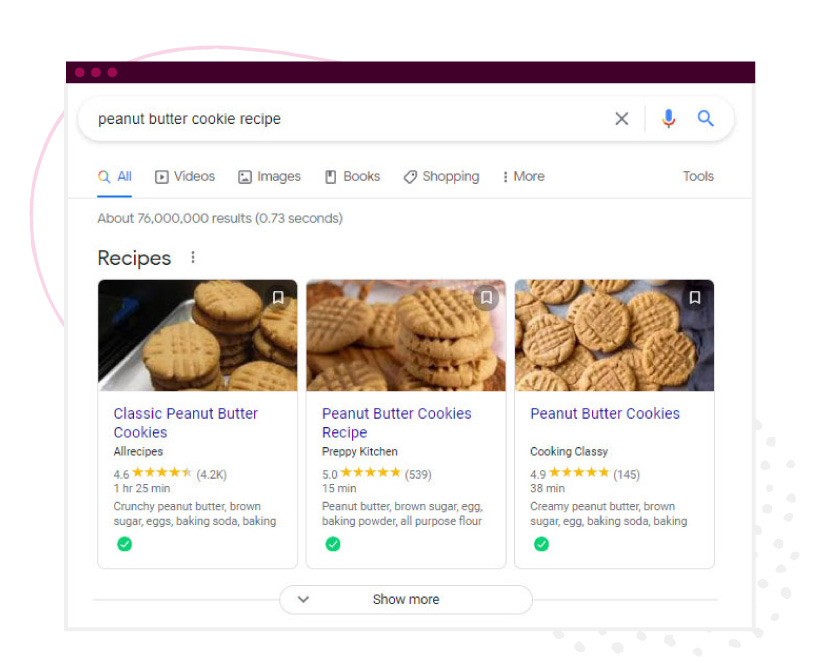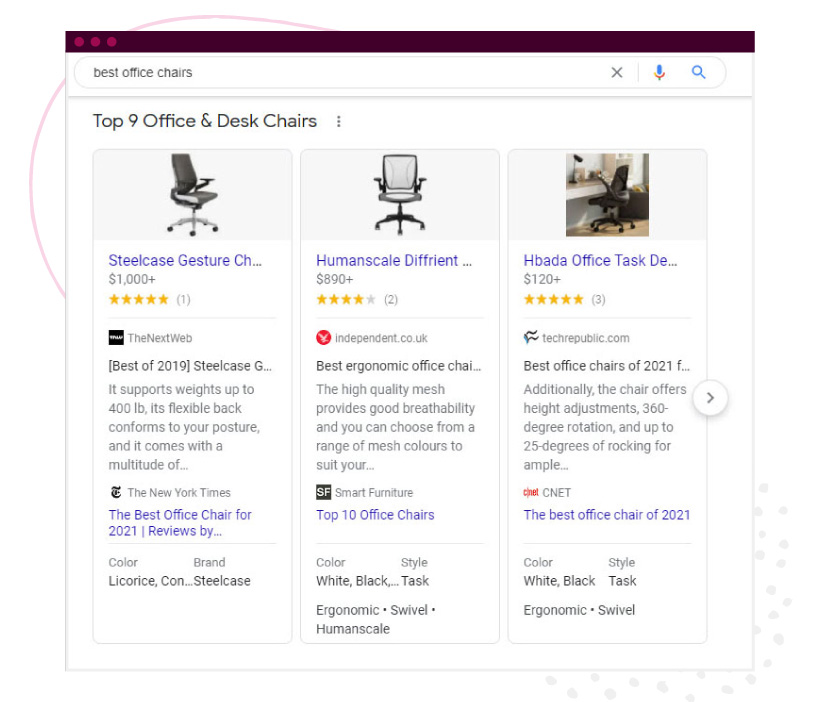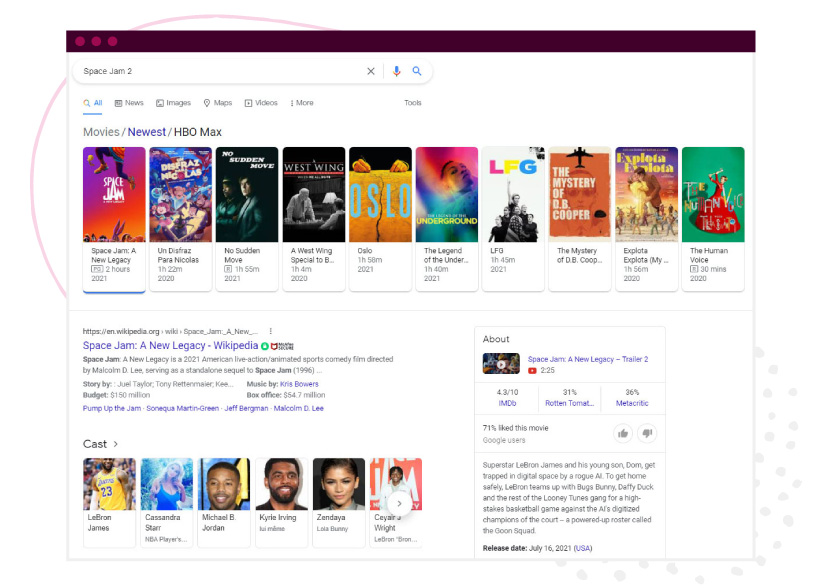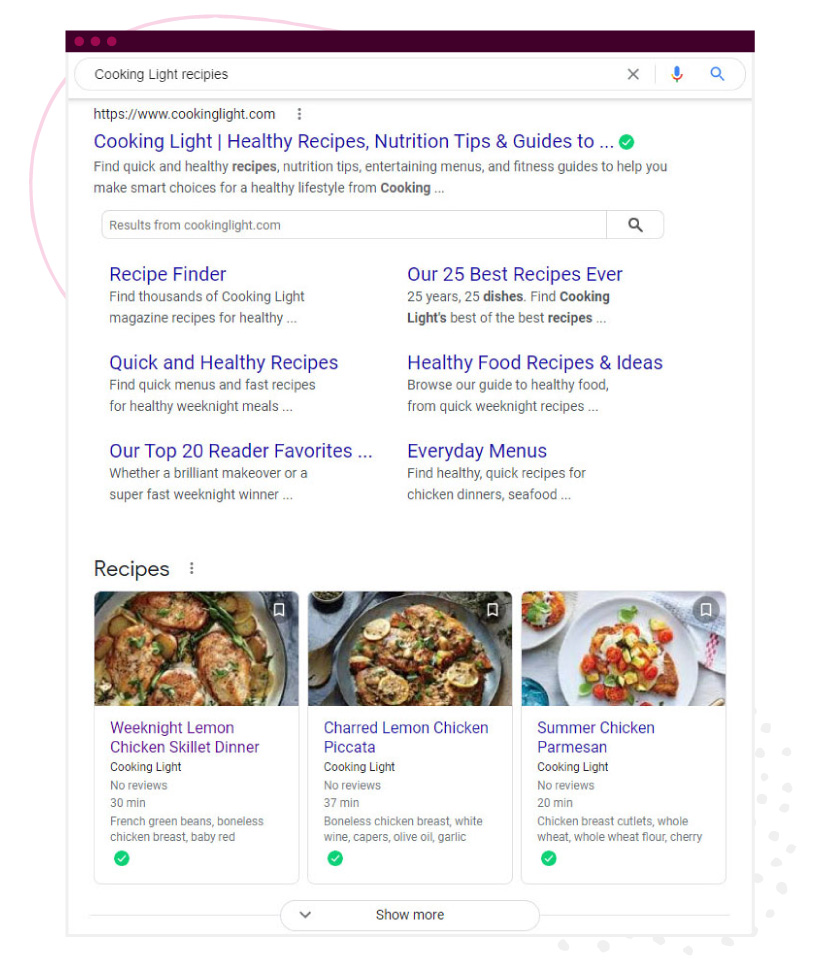What are Google carousels? Google carousels consist of a list-like rich result, presented as a collection of images that depict products or topics within your search parameters. These images can also offer a brief caption and link back to the original website.
Has this happened to you? You find yourself with a hankering for a particular sweet. But not just any sweet. You want homemade peanut butter cookies but don’t have a recipe for this treat.
So, you head to your computer or smartphone and input “peanut butter cookie recipe” in the search engine. The result isn’t a listing of recipes but rather photos of delicious-looking cookies with ratings, recipe sources, and partial ingredient lists. Welcome to the carousel realm.
What are Google carousels?
No, these aren’t those massive merry-go-rounds you see at amusement parks. In the SERP world, carousels consist of a list-like rich result, presented as a collection of images that depict products or topics within your search parameters. These images can also offer a brief caption. When you click on the carousel image of your choice, you’ll be directed to the original website.
As with other search engine-oriented widgets, carousels are in place to help define and refine user search preferences, especially when it comes to general topics. For example, “peanut butter cookies recipe” is a broad topic. Presenting photos and brief descriptions can help you further refine what, exactly, you might be looking for.
Google carousel examples
While carousels are in place for a single purpose — to help meet user intent with other options — these widgets come in a variety of formats. Here are some examples.
Top products carousel
This Google feature lists products that fit into the “best-of” category. If you type “best office chairs” into your search engine, you’ll find a list of three office/desk chairs, with the following information:
- Product name and image
- Average rating (collected from review sites)
- Product features
- Horizontal scroll
The latter will provide you with access to more products and information.
List carousel
The list carousel is the most common type of this widget. The above-mentioned peanut butter cookie recipes are an example of a list carousel. Other list carousels can include sports team rosters, Segway retailers, and movies, such as the example listed below.
This list carousel highlights movies showing on HBO Max. Clicking on ‘Space Jam: A New Legacy’ brings up more information about this particular movie, including cast members, a Wikipedia entry about the movie, and a knowledge panel.
Host carousel
Host carousels consist of products or topics from a single website. At this time, Google supports only four types of hosted carousels: course schedules, recipe lists, movie lists, and restaurants. This recipe list carousel comes from the Cooking Lite website. Unlike other carousels, this one is not on top of the SERP, and it offers a vertical expansion as opposed to a horizontal scroll.
Benefits the carousel provides
Here’s what carousels can do as part of a SERP.
- Sharpen user intent. Many users who turn to a search engine might not have a clear idea of what they’re looking for. Like the above-mentioned peanut butter cookies, users know what they want. But they’re not sure how to get from where they are now to their end goal. A carousel can offer a path to that destination.
- Demonstrate different options. Many times, there could be a better alternative out there for a product. For example, a peanut butter cookie recipe with chocolate chips might pop up on the carousel. This could end up being an even more delicious option for you, especially if you like the idea of chocolate and peanut butter.
- Provide valuable insights. Rich content on carousel cards show more than images. They also might include brief captions about what’s in the picture and perhaps a review or two. Adding to this benefit? All the information is on one page, where it can be compared.
- Offer additional in-depth content. Each carousel image is a link to somewhere else: the source website. If something strikes your fancy about that image (and the written content), it’s easy enough to click through to obtain more intelligence.
What type of content is used for the list carousel?
How does Google put together its carousel listings? It relies on structured data. Structured data is information (i.e., data) that is organized in a specific manner (i.e., structured). This is accomplished through various procedures, such as that found on schema.org and similar websites. The main goal of structured data is to communicate web page information, so Google will examine it, and display that information as a rich result on a SERP.
Now, you don’t just write structured data. Structured data is a markup language and is also a form of metadata. As such, structured data content is seen by search engines, rather than human beings. Thanks to structured data, search engines understand what a product image is, without having to rely on algorithms.
When handled correctly, sites with structured data can find themselves in carousels or other featured snippets on a SERP. Overall, carousels could be considered the listicles of the search engine ranking page arena. They can help you clarify your intent as a user. And, when used correctly, carousels can help companies stand out competitively.
Want your brand to have better visibility on Google and other search engines? High-quality content is the answer. Talk to a content specialist at ClearVoice today.







